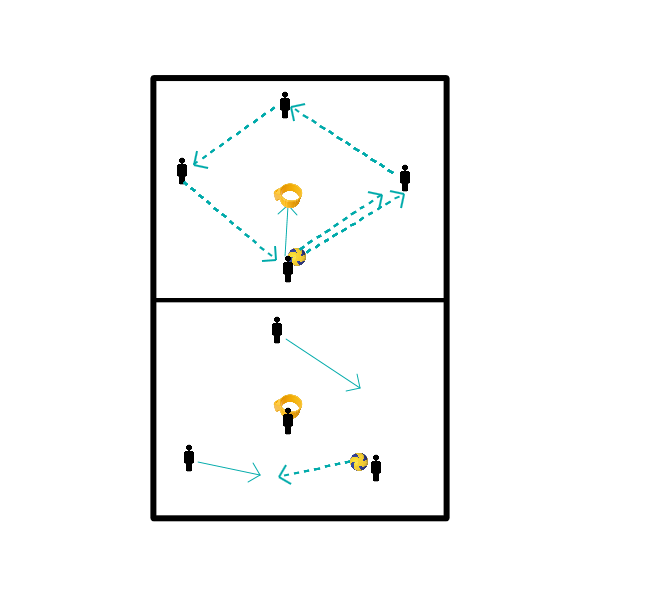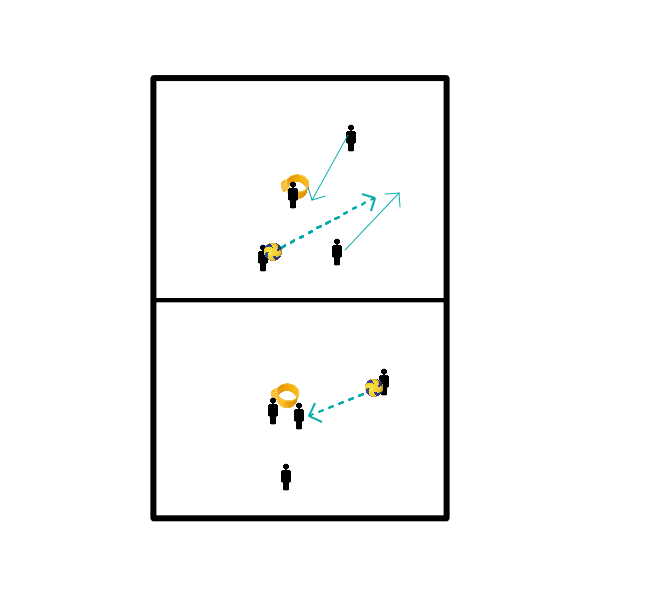Korfball drills
Start line-up
Two groups at the first two pawns.
Exercise
- The first in line runs to the hoop and goes through the hoop from the bottom, so the hoop goes over their heads.
- Then he runs through the defence posture to pawn two and circles this in 4 circles.
- Finally, he runs to pawn 3 and scores before he can run back to pawn 1 and tap the next one in line.
Set-up distance:
Hoop from pawn 1: 5 meters.
Pawn 2 from the hoop: 5 meter.
Pawn 3 from pawn 2: 5 meter.
Pole from pawn 3: 4 meter.

- Put out a square of 20 by 20 with hats.
- In the middle put balls (1 less than the number of players)
- The players walk in circles around the hats
- At the whistle they run in and try to get a ball
When you have a ball you can try to shoot (penalty throw - distance) and if you score you have a point, at every new round one ball less in the middle. The players who don't get the ball keep running.
Children run and throw the ball over within a defined area.
- There is one ticker.
- Who has the ball may not be tagged.
- You may hold the ball for 8 seconds.
- The catcher may not stay with the person with the ball.
Make it more difficult with several balls.
- Form 3 teams at the basket
- Person 1 stands 3 to 4 meters in front of the basket near the pawn.
- Person 2 will stand 3 to 4 meters behind the basket near the pawn.
- Person 3 stands under the basket as catcher
- Person 1 starts shooting, person 3 catches the ball and throws it to person 2.
- Person 2 shoots, person 1 catches and throws to person 3. Always change.
Exercises with distance shot, penalty throw and walkthrough.
You start shooting from a fine distance
- Did you score? Place a pawn next to the post until you have used up all your pawns.
- Then you can shoot as many balls as the number of pawns you have.
- When you have scored, you must take a pawn and put it on the other side of the pole.
- The amount of pawns that you have left, you can use for penalty throwing
- The team that has the most cones left has won
- Make 2 squares of 4.
- The attack takes the ball from the trainers.
- When the defence has intercepted the ball, they first pass it back to the trainers.
- When a goal is scored, the team gets a bonus and can take the ball back out.
Do give orders, for example:
- Start in a diamond. Let the ball go around 1 time.
- The player in front throws the ball next to him/her one more time and catches it.
- The other players continue playing. The player who has the ball now chooses whether he wants to throw to the left or to the right. The other players run to the ball to pick it up. The ball is thrown and the player immediately runs a long line.
The long line is nudged and the thrower comes alongside. The other player walks behind the basket to walk into the support. The other two are going to attack.


Place 2 cones at the same height 4 meters apart.
Start with a pawn at 6, 12 and 20 metres.
Divide the team in 2 groups. Fight each other in relay. Number 2 can start when number 1 is at the 2 pawns. Which team is back first?
Repeat 3 times
- 3 persons per basket.
- The players take turns in catching and marking the ball.
- The runners start at the pawn at about 15 metres. They calmly walk towards the basket and at about 2,5 meter distance they get the ball and pass it underhand.
- The handler catches the ball, gives it to the next handler and walks to the cone.
- When necessary they get tips and help.
Place a number of cones/caps 2 to 3 metres apart. Make two rows of cones and divide the team into two groups.
The exercise is quite simple. One pawn sprints and one pawn knees high. Go behind each other
Inshort: exercises in catching balls that bounce or roll at the right moment.
Organisation: one ball per pair or trio.
(a) The numbers 1 and 2 of each pair stand next to each other. Number 1 rolls the ball a few metres away. Number 2 has to get the ball, pick it up and throw it back as fast as possible. Change after 5 games. Make sure the players 'get' the ball as soon as possible by putting one hand on it as soon as possible.
b ) As a., but now number 1 throws the ball away with a small curve, in such a way that it bounces on the ball at a distance of about 4 metres (and then makes a bounce of about half a metre high). Number 2 must try to get the ball as soon as possible after the bounce.
c ) As b., but now number 1 drops the ball from a height of 1.5 metres just in front of number 2. He/she has to try again to get the ball as soon as possible after the bounce. It will appear that almost everyone lets the ball rise a little and then catches it. Wrong (in the meantime an opponent can quickly put his/her hand on the ball). At the very moment that the ball is about to come up, the hand should be placed on the ball Take the ball!
Exercises:
1) Doubles: 2 players facing each other, 1 player walks from left to right, the other throws the ball, always playing on the outside hand. Catch ball, return same hand, walk to the other side. Change function after a few times.
2) As 1 but player takes ball over, i.e. catch right hand, pass to left hand and play with it, walk to left, catch with left hand, pass to right hand and play with it etc. footwork
Inshort: practise various forms of the shot in a fun competition format.
Organisation: each group a basket and a ball, the baskets are preferably (but not absolutely necessary) arranged in a circle or rectangle. The number of people per group is less important (all groups should be about the same size).
Pawns set up at 1,3,5 metres
The first assignment for the groups is: make 10 goals. When you are done, the creator of the last goal goes to the trainer to get the next assignment. Which group will have completed all assignments first?
The trainer walks around the room, encouraging or correcting the players. He has a piece of paper with a list of assignments. When someone comes to get the next assignment, first ask him which assignment he just completed (after a while this can vary considerably) and then give the next one. Here's an example: 10 walk-through balls, 15 penalty shots, 5 shots from 8 meters, 10 walk-through balls from behind the basket, 5 dodgeballs next to the post, 10 shots from 6 meters. Everything is possible of course, a lot of momentum comes from keeping the number of goals to be scored small.
Tasks:
- 6 scores from 2,5 meter in front of the basket
- 6 scores from 1 meter in front of the basket
- 6 scores from 6 meter in front of the basket
- 6 scores from 2,5 meter behind the basket
- 6 scores from 1 meter behind the basket
- 6 scores from 6 meters behind the basket







